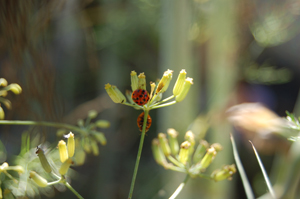
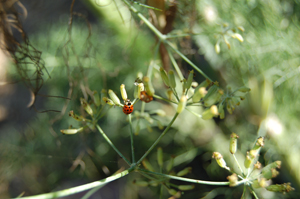

[Fennel]
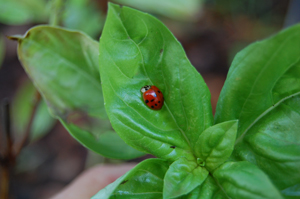
[Sweet Basil]
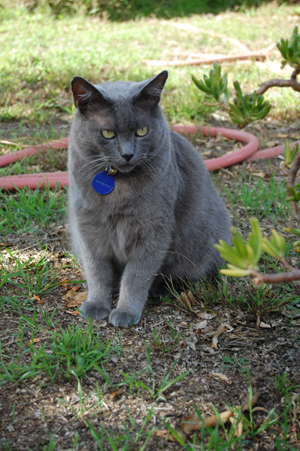
{Vlademere]

[TR aka the-little-ball-of-fury]



[Fennel]

[Sweet Basil]

{Vlademere]

[TR aka the-little-ball-of-fury]

I put aside other knitting projects in order to finish the Basil Baby blankets before the twins go off to college. (They recently celebrated their 2nd birthday.) Going along fine until I started looking at other completed Basil blankets (on Ravelry) and realized that I had managed to knit up the borders (- count two – both sets of borders – ) incorrectly (backwards, insideout, don’t ask) and had myself a lesson in careful frogging. Now back on track and I may yet complete this project before the college going away party….
I don’t generally buy stuff for myself this time of the year. I enjoy picking things out for people in my life or making the thing(s) myself. In fact there are a couple of scarves I should be working on at this moment and then there are the ubiquitous Basil baby blankets that need completed borders. 
The excuse here is that the combination of art and herbalism got to me. My copy of the Druid Plant Oracle arrived today. It wasn’t available locally so I can’t say I ran out and bought it but had to run to my computer, order online and wait.
First off, I’m not an experienced tarot reader (and this isn’t actually a tarot deck). I have my well-worn SMITH-ryder-waite deck for personal use and that’s the extent of my experience.
Secondly, I know next to nothing about Druids, ancient or modern.
But I think I can say I have a decent grasp of dye plants and am interested in botanical pharmacology. Included among the images are plants any dyer would love: Madder, Woad, Plantain and Yarrow. Before I saw the leaves, I thought the image on the cover was Oxalis but it’s Primrose. Lots of the standard medicinals: Clover (Red), Chamomile, Comfrey and the like.
Good bibliography and a list of plants by common, Gaelic and botanical names. And the images are gorgeous. (Can’t emphasize that part enough.) Also included are three blank cards so you an add your own plants. (Right now I think I’m planning on Fennel, Oxalis and Cotton.)
Got an herbalist or dyer in your life? Perfect gift. If the herbalist/dyer is into Celtic history and mythology, even better. And the images are gorgeous.
Deck developed by: Philip and Stephanie Carr-Gomm.
Illustrations by: Will Worthington.
They also designed a Druid Animal Oracle deck and a Celtic themed tarot. 
What is the deck like to read with? Don’t know (yet). I’m still into the accompanying book. Perhaps see the review over at the Aeclectic Tarot site.
However, if my maternal grandmother is an example, one can read with any sort of deck, even a standard playing card set that has a weird poodle design on the backs.
Here is the back story. My mother’s mother was not into anything remotely metaphysical or new age-ish. She was a fanatically conservative Catholic slightly to the right of Savanrola (alternatively see Spanish Inquisition). But bizzarly, conversely, she also “read”, if you can call it that, from the afore mentioned standard playing cards.
As far as I could tell, she did not read using any traditional method or symbol set. They functioned as a jumping off point when she was inclined to pick up things. At that she was annoyingly accurate. Her readings occasionally precipitated a phone call from my mother. Usually because my grandmother – should she think something was up with me – would badger her daughter (my mother) until Mom called me to check in.
So, long digression aside, yes – if it fits your practice you probably can read with this deck. And the images are gorgeous.
My standard yellow dye plants are Fennel (for wool) and Oxalis (cotton, wool, soy silk).

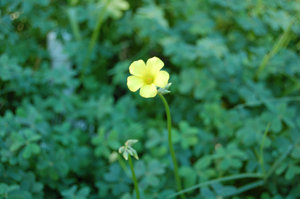
The first Oxalis opened up a few days ago. Locally the Fennel produces through most through what would be our Summer months (Pacific, southwest USA), starts to dry and dies out around Autumn. Following that the Wood Sorrel/Oxalis starts up, runs rampant through the Winter into Spring and dies out towards summer when the Fennel starts up again.
This being southern California the seasons are hot and dry, and really hot and dry punctuated by a furious rain storm or two. In fact, left to itself I am guessing much this area would be more desert like. (In case one forgets this idea, having a car breakdown in the San Fernando Valley, in July, around high noon, is a heck of a wakeup call…) Most of the years I grew up here the weather was at least consistant with itself but lately has gotten incresingly volitile (and just plain wierd).
Otherwise, the cotton is still opening and some smaller (cotton) plants have been started for next year.
After following the Knitpicks sock blank knit-alongs and dye-alongs I decided to try one myself using dye plants.

Knitpicks sock blank. Starting with an overnight soak and standard Alum bath.

Start with Oxylas. The sock blank soaked up the dye incredibly well. I underestimated the wicking effect and lost the white spots. For the next one it mgiht be interesting to try with some dry areas.


Overdye with Maddar.

Some ‘saddening’ with Iron and Copper to tone down the yellow.

Last the Indigo overdye.


I am a total convert to the Magic Loop method of sock knitting but have never tried two at once or toe up. The pattern is good but I was somewhat confused at the beginning. Once over that hurddle I think the rest will be fairly straight forward.
The woad continues growing out and now up. In one of the pots some volunteer basil appeard, which means Pesto sauce as well as blue dye.



I wasn’t sure how the particular plant would manage in a hot, dry (Southern California) climate. It seemed to start out slow last fall and really took off around the beginning of summer.
Should anyone else be interested, here are a couple of Woad sites:
Woad Inc
Rowan’s Woad Page
Yahoo Group: woadgrowers


Around the time that the Oxalis was dying off the Fennel seemed to take off. It looks like I won’t be scavenging the Smart-&-Final parking lot or sides of freeways for Fennel this year. The backyard stand – now too large to be called a shrub – is producing enough to keep me in dye and local insects in food.




Also here, my first attempt at growing Woad. There are 2 plants, still in pots. One seems to have some Sweet Basil growing along side – probably from some other planting. They are about 6” across right now. I’m not sure how fast these grow but it is unlikely there will be blue dye until next season.
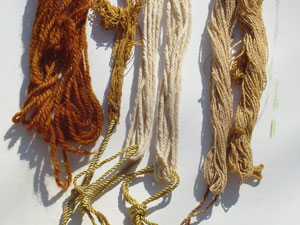 I tend to work with dried dye plant material rather than fresh. My gardening space is on the small side. Even with ‘weeds’ I rarely have enough fresh material so I’ve been concentrating on plants I can dry and save up over time.
I tend to work with dried dye plant material rather than fresh. My gardening space is on the small side. Even with ‘weeds’ I rarely have enough fresh material so I’ve been concentrating on plants I can dry and save up over time.
Red and blue aren’t a problem because I can purchase Madder and Indigo already dried. Onion peels (yellow to orange and rust) are dry and easy to store. Usually its the yellows that need some planning. Fennel is my local dryable yellow for wool and Oxalis for cotton (although it works on wool too). The dye books I’ve been reading tend to discuss the plant to dye stuff radio in terms of fresh dye material, often 1:1 (dye material:fiber) or in the case of cotton as much as 2:1 (dye material:fiber). The weight drops quite a bit in the drying so I did some before and after weighing to get a better idea of how much to use.
The dried Oxalis seems to be about 12% of the fresh. Which means 1:1, 2:1 or anything like that is way too much dye material.
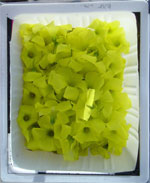 Fresh material weighed .9 oz or 25 g
Fresh material weighed .9 oz or 25 g
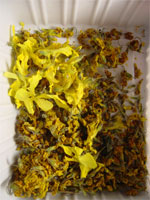 Dried material weighed .1 oz or 3 gm.
Dried material weighed .1 oz or 3 gm.
For a long time I’ve used my trusty triple beam scale for measuring dye material. This had been given to me by my father. He always used a triple beam scale for measuring ceramic glaze chemicals and it was one of those things he thought I should know how to use correctly, along with tire changing and other useful stuff.
Recently I got my first digital scale. Obviously it must take very little to make me happy. I love the push-button tare function. (Way easier than zeroing out my old standard.) Also being able to switch between metric and that other thing by pushing a button. Even the cats like it.



(before and after)

Cotton samples, 50% and 25% DRIED plant to fiber, and then on the far right extra samples tossed into the 50% and 25% dye soup to exhaust the dye. The extra samples (in order) were wool, soy silk and cotton.
So far my most successful cotton processing has been derived from Jill Goodwin’s “A Dyer’s Manual” – a book both beautiful and useful.
Jill Goodwin method: soak the cotton at least an hour (overnight in this case); “mordant 8 oz of cotton, dissolve 2 oz of alum (60 grams) and half an oz (4 tsp or 20 ml) of washing soda in a pot of boiling water” – ok ounces make my head ache, I use metric for dye work so I calculated this to alum 25% (.25 x weight of fiber) and washing soda 6% (.06 x weight of fiber); boil cotton in alum and washing soda for half an hour, stir occasionally.
I simmered the dried oxalis (contained in a pantyhose foot) and the cotton for about an hour and cooled overnight, around 24 hours.
Goodwin suggests that you use 2x the weight of the material to be dyed. however I have found that dried dye material is quite a bit stronger (concentrated?) then fresh. The color on the photo I have posted here is definately not perfect but gives a general idea of the color. The fiber is darker in the dye liquid but even after the washout I had a decent medium and deep yellow. I plan to try a 10% for a lighter yellow.
The surprise was the amount of color left in the dye liquid that was picked up by the wool, soy silk and 2nd cotton samples. The light yellow samples I will probably over dye with indigo.
In the area of Southern California where I live, Oxalis is one of those frighteningly hearty and unstoppable plants that appear wanted or not. On the positive side, this is one of the few local plants I’ve found that works well on cotton and produces a nice bright yellow. (Samples on the way). And the bees really seem to enjoy it.
The Oxalis reappeared this year around late November. Generally as soon as it shows up I start picking and drying it (paper bag hanging in the hall near our floor heater vent) so there is enough on hand for a decent dye bath.
Oxalis fresh, and dried.